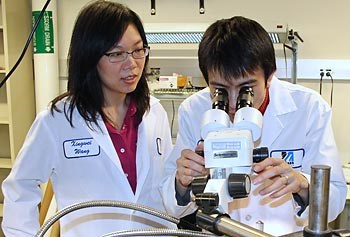$75K in Funding for Studies in Ultrasound Imaging, Cancer Diagnosis, Elastomeric Sealant

Electrical and computer engineering Assoc. Prof. Xingwei Wang, left, works with postdoctoral researcher Nan Wu in the Center for Photonics, Electromagnetics and Nanoelectronics.
07/24/2014
By Edwin L. Aguirre
Coronary artery disease, or heart disease, is the leading cause of death in America, claiming the lives of about 600,000 people each year. The disease results in the narrowing of small vessels supplying blood and oxygen to the heart, leading to blockage and, possibly, heart attack.
For their part, electrical and computer engineering Assoc. Prof. Xingwei Wang and her research team are developing a new, compact ultrasound imaging system that can help evaluate and diagnose patients with coronary artery disease and reduce the cost of treatment.
“Our goal is to develop the first all-optical-fiber ultrasound imaging transducer with automatic steering function that could see deeper into the heart tissues with higher resolution,” says Wang.
Wang is one of three university researchers who have been awarded this year’s Commercial Ventures and Intellectual Property (CVIP) Technology Development Fund by the UMass President’s Office. The annual grants, established in 2004, are intended to assist faculty researchers from across all five UMass campuses in accelerating the commercialization of their cutting-edge discoveries and inventions.
Wang’s fellow CVIP grant recipients at UMass Lowell are Assoc. Prof. Anna Yaroslavsky in physics and Prof. Rudolf Faust in chemistry. Yaroslavsky was selected for her efforts in developing an innovative breast cancer imaging technique using polarized light, while Faust was chosen for his work on creating an elastomeric sealant for industry. Each researcher receives $25,000 in funding. A total of eight CVIP grants were given this year, including those to faculty members from the Amherst and Worcester campuses.
World’s Smallest Ultrasound Transducer
Wang’s proposed technology is completely different from current commercially available ultrasound imaging systems because the planned transducer will be very small, only 375 microns in diameter, much smaller than the width of a human hair.
“The transducer can optically steer the generated ultrasound beam through the blood vessels without the need for any mechanical structure,” explains Wang. “The transducer also features an ultra-wide bandwidth, which will provide high-resolution imaging. To the best of our knowledge, this will be the first all-optical miniature ultrasound imaging probe that can reach ultrahigh frequency, high resolution and automatic steering capability. This technology will have significant impact on the ultrasound imaging market.”
Wang will use the CVIP funds to assemble the fiber-optic generators and receivers and demonstrate the feasibility of optically steering the generated ultrasound waves.
“This will allow the imaging system to ‘see’ the sidewalls of the blood vessels instead of just looking straight ahead,” she adds.
Using Polarized Optical Light for Biopsy
Breast cancer is the second-leading cause of cancer-related death and the most frequently diagnosed cancer in women in the United States. Its incidence has increased considerably over the past few decades.
“Great advances have been made in the early detection of breast cancer, but it’s still difficult for pathologists to identify single cancer cells,” notes Yaroslavsky. She says current methods can take several hours to prepare the tissues for microscopic examination. In addition, diagnosing cancer cells in specimens can be challenging and can result in false-negatives or false-positives.
“Therefore, there is an urgent need for rapid, objective and quantitative approach to diagnosing cancer on the cellular level,” she says.
Yaroslavsky and her team have developed an innovative method that uses fluorescence polarization of light for the biopsy.
“Fluorescence polarization has never before been attempted for detecting cancer in single cells,” she explains. “One of the major advantages of this imaging technique is that it can be done rapidly and in vivo. By analyzing fluorescence polarization in single cells, we are able to differentiate cancer early and accurately, before the cells develop into a palpable mass.”
When fully developed, the technology will also be invaluable in monitoring patients who are in remission, when it is important to detect single cancer cells that were not removed by surgery and may have become resistant to chemotherapy or radiation, Yaroslavsky states.
Extending the Life of Solar Cells and LEDs
Faust’s goal is to develop a self-healing, gas-impermeable elastomeric sealant that would help protect solar cells and LEDs from harsh environments.
“Organic photovoltaic cells and light-emitting devices are susceptible to damage when exposed to moisture and oxygen, dramatically decreasing their useful lifetime,” he says. “Our project aims to advance our novel polyisobutylene-based sealant technology from proof-of-concept stage, which has already been demonstrated, closer to commercialization.”
Faust will use the CVIP grant to support for six months a postdoctoral researcher who will be working with him in the lab.
Investing in Innovation
Over the past 10 years, the CVIP program has funded 82 projects, resulting in numerous commercial licenses and patents, five start-up companies and more than $3 million in additional research funding.
“Every year, we identify game-changing research with commercial promise in laboratories on UMass campuses that speak to the major role that the university plays in advancing scientific discovery and improving and saving lives in the Commonwealth and around the world,’’ says UMass President Robert Caret.
“It is critically important that the university help advance these projects so that they can enter the marketplace and contribute to increasing our entrepreneurial activities and rate of commercialization of early stage technologies, as well as support the Commonwealth’s overall economic development efforts.’’
